feb
Pictures of the climate theory of progress

The 21st century has brought many discoveries and computing technologies. Allowing the humanities to move into the category of natural sciences
Positive evolution of cooling matter
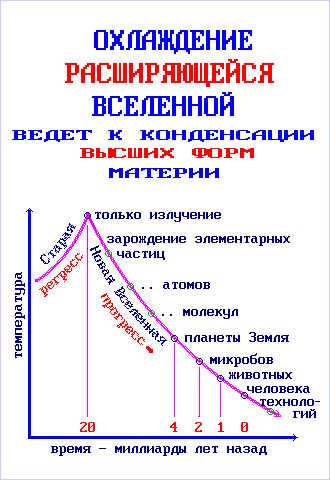
The expansion after the Big Bang is accompanied by cooling and "precipitation" of more and more organized forms of matter. It is important that the cooling is not too fast
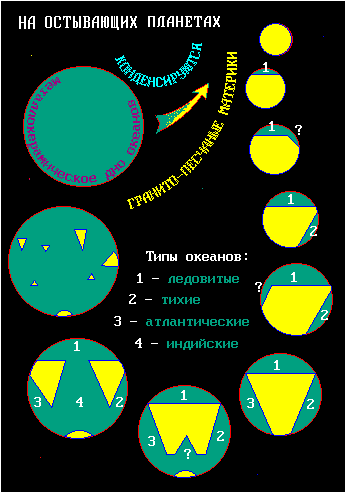
It is believed that after the accumulation of heavy products of thermonuclear "burning" in the Sun, it threw them out by means of an explosion.
At the same time, the heaviest products flew away and formed solid planets. At first, their surface was (?) a lot of islands floating in a molten ocean of magma.
The islands were outcrops of light rocks from the body of the planet, like multiple foam fountains in a boiling pot. As the planet cooled, the area of the islands increased to the continents.
At the last stage of cooling, the planet turns into a continuous continent, with the possible exception of a small lake-ocean. As the planet cools, the number of convective cells decreases in the bowels of the planet.
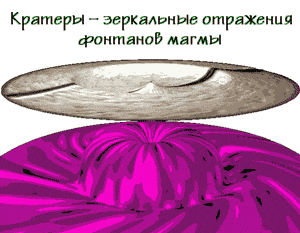
The thin and dense oceanic crust of the planet is the gushing outlet of the convective cell and is its mirror image. With an annular ridge along the edges and an elevation in the center.
This applies not only to the oceans, but also to (?) large craters

Perhaps, after its birth, the planet Earth also cooled. At the same time, more and more organized forms of the biosphere "precipitated".
Perhaps the cooling was uneven and tied to the rotation of the solar system around the center of the Galaxy
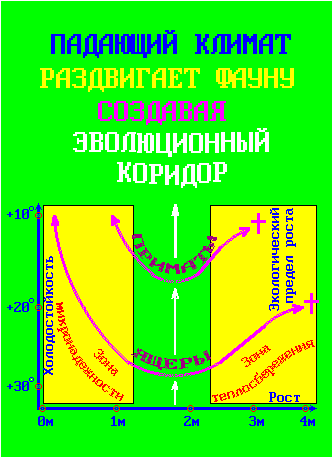
As the planet cooled, a positive evolution of the biosphere took place. It occurred with the greatest speed in the central growth zone,
which was the most dangerous. The growth here is too great for the regeneration of the body. And too small to effectively retain heat

The tree of positive evolution has taken the form of a central trunk in the most progressive growth zone. From which certain species are evacuated from time to time
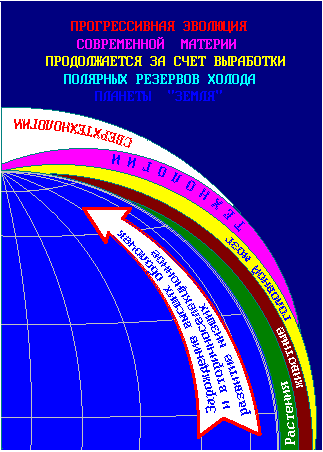
When the Earth lost its original heat and therefore stopped cooling, the positive evolution of the biosphere continued due to the gradual migration of species from the equator to the poles of the planet.
The biosphere grew on the soil of the lithosphere. And, in turn, became the ground for the emergence and growth of the technosphere. Technology is also evolving positively through gradual migration towards the poles.
Without migration, positive evolution stops sooner or later, reaching the temperature ceiling of positive evolution. Under Earth conditions, the height of this ceiling is approximately equal to
temperature in degrees Celsius of the coldest month of the year in the region, taken with the opposite sign.
For example, the ceiling of the positive evolution of the equator is -24, England and France is -5, Germany - 0, Russia +20
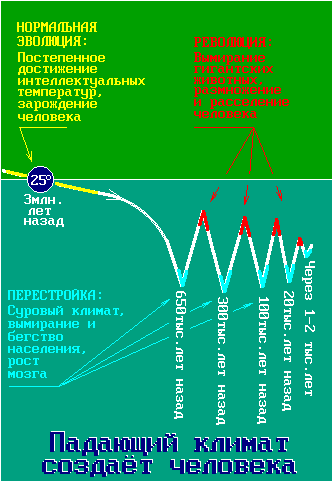
For the last ten million years, the Earth has practically ceased to cool. The temperature began to fluctuate around the average level. During periods of temporary cooling (ice ages)
there was an intensive positive evolution of species. And during periods of warming (interglacial) - population explosions and migration to the poles

The modern interglacial period has caused not only another population explosion, but also the growth of technology with their migration to the poles

The black horizontal line is the region's development ceiling. It is shown that almost any species that has entered the region tends to align with the ceiling.
The only exceptions are the most undeveloped species, for which the cold of the region is either deadly or depressing. Some degradation of the view towards the ceiling has occurred, for example,
when the descendants of the biblical Ham migrated from the "promised land" (the eastern Mediterranean and the Arabian Peninsula) to Africa. We observe the same picture when people move to the big "island" America
(small area of the islands also lowers the development ceiling). The lower falling curve corresponds to the fall of the polar (Russian) civilization during the "perestroika" removal of the Sun from the Earth

Under the pressure of the climate ceiling of development, advanced technologies migrate from the equator to the cold poles. On planet Earth, from across the Southern Ocean, effective migration is possible only to the north pole of cold (Oymyakon-Verkhoyansk)

Stages in the development of advanced technologies and their migration to the North Pole of Cold

The globe of positive evolution differs from the geographic one in that the pole is not located in the Arctic Ocean, but in the region with the most severe frosts (Verkhoyansk-Oymyakon)
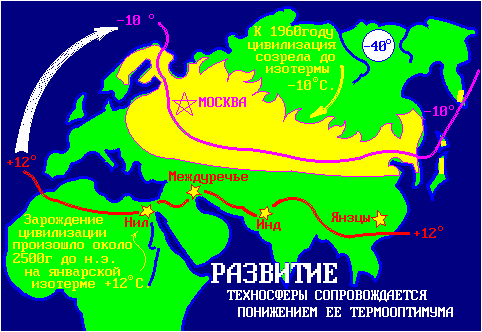
Earth civilization began its journey in the subtropics and moved in a growing wave to the Pole of Cold (Verkhoyansk-Oymyakon)

In the 20th century, civilization reached the zero January isotherm ("economic miracle belt")

The computer calculates the forecast of the technosphere for the 23rd century
Historical cycles of the Earth's orbit shift

There is a hypothesis about the existence of approximately 2000-year "moraine cycle". Therefore, it is possible that the eras of the Middle Ages and the Renaissance were repeated more than once in history.

The same hypothetical cycle in Africa

And in the geography of the movement of the center of civilization

And in architecture. At the bottom of the figure, a smaller cycle of 165 years is visible (one rotation of the large planet Neptune or two rotations of the large planet Uranus).
This "small" cycle is caused by the displacement of the Earth's orbit by the attraction of the larger planets. The study of the history textbook showed that when the June Sun approached
the development of the northern regions is accelerating. And when removed, it weakens. At the maximum and minimum distance, the combat losses of the population of the North increase
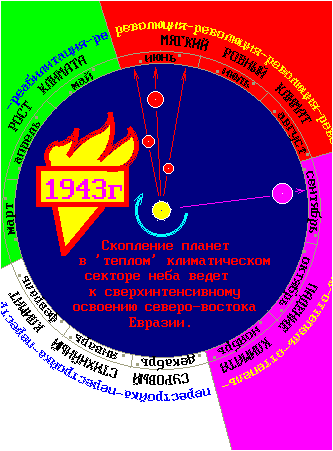
An example of the closest June Sun

An example of the maximum distance of the June Sun

This removal in advance caused a slowdown in the development of the north pole of cold (Russia-USSR). And then led to its temporary decline.
In the figure, blue dots show the disappeared lights of civilization in the period 1990-2000.

The close June sun is summer warmth. This is what the summer heat chart looks like. At the top and bottom of the graph, combat losses of the population increase.
The descending branch of the graph can be conditionally called the era of "enlightenment". And the ascending - the era of "rehabilitation".

Loss of population is especially strong when the Sun is close, when a large planet sets in the rear of the June Sun. The figure shows the population loss in China. Probably the picture would be clearer
if the influence of Neptune were not superimposed by a similar influence of Uranus, Saturn, Jupiter. A similar pattern of losses was observed in Ancient Rome and Mesopotamia
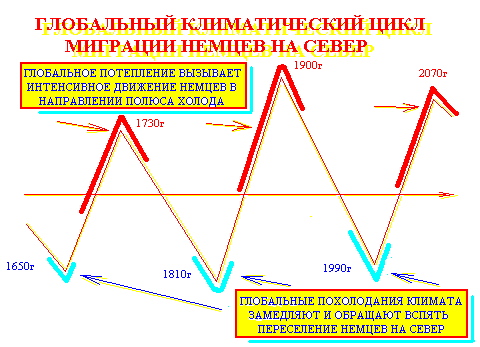
When the June Sun is close, the areas where people (and animals?) live are somewhat shifted towards the cold pole. And vice versa

The calculation shows that the displacement of the Earth's orbit by the attraction of the giant planet is small compared to the displacement from the Moon. But the duration of this displacement is hundreds and thousands of times longer than the lunar one.
This probably enhances the impact. The biosphere is much more sensitive to displacement than non-living matter.
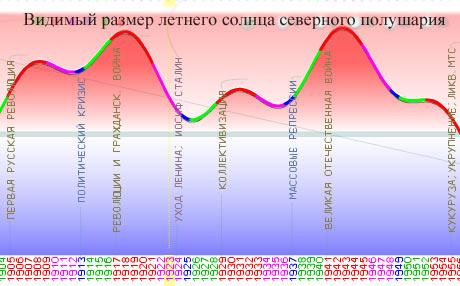
The close June Sun against the backdrop of advances in medicine and a population explosion provoked two world wars.
In between, the Sun has retired, giving rise to an era of relative calm called the NEP (New Economic Policy)

After the Second World War, the Sun began to move away, which gave rise to the Khrushchev era of the "thaw", and as a result, temporarily brought down the civilization of the pole of cold (Russia).
The withdrawal of the Sun also gave rise to two "thaws" during the reign of Mao Tse Tung in China. In the 21st century, the June Sun began to approach, which led to a gradual recovery of the economy and territories of Russia

In 2002, based on the movement of the June Sun, a political forecast was made for Russia for the 21st century

In 2003, based on the movement of the June sun, an economic forecast was made for Russia (yellow line) for the 21st century
Comparative Anatomy

The stronger the winter cold in the region (or the closer the pole of cold), the larger the brain of animals and humans. For example, the Indonesian orangutan has a brain approximately 20% larger than an African chimpanzee.
In humans, the brain approximately grows from the equator of Africa to the north pole of cold. More precisely, slightly to the east due to the influence of the less significant Canadian pole of cold. Therefore, the owners of
the largest brain in the world are the inhabitants of the Aleutian Islands. However, there is a nuance: too severe frosts make the growth of the brain less "quality" - the motor and ancient sections grow, but not (?) the logical sections grow (Neanderthal syndrome).
Recall that intelligence and brain size are slightly different things. Intelligence is equal not just to the volume of the brain, but to the volume of its logical departments, multiplied by the level of technological development of the regions.
Civilization is an artificial jungle. Therefore, the long-term impact of a developed civilization on the population leads to a decrease in its brain volume.
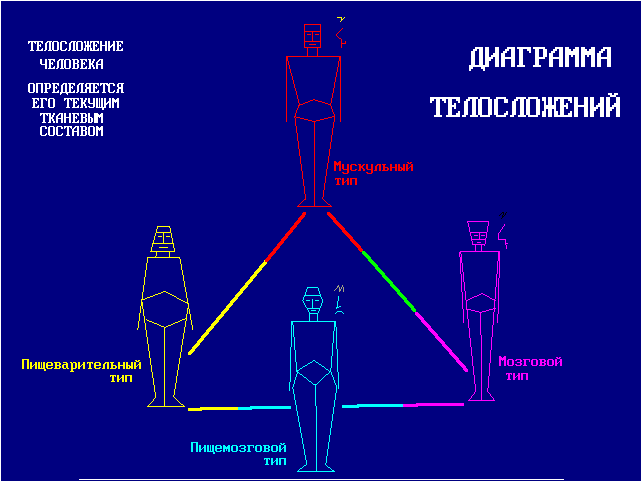
Just as in an anthill there are ants of different specializations, people are also born different. By analogy with the RGB color scheme, they can be classified according to the dominant body tissues as
the following types: digestive, skeletal-muscular, skin-brain, food-cerebral. Each of these types has a field of activity with which they cope best (figure below)
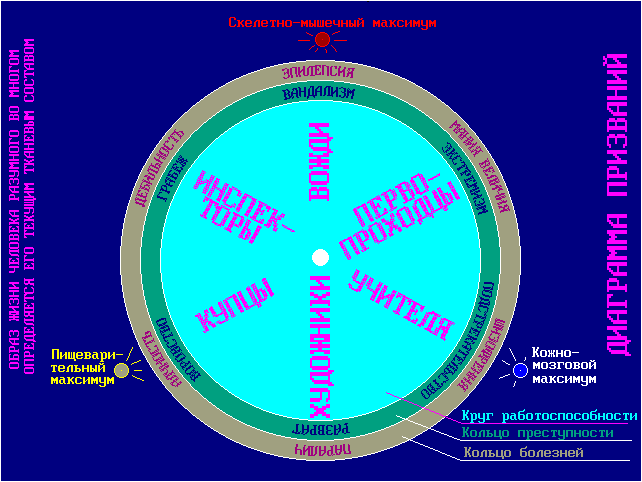
People of the digestive type are excellent businessmen, the skeletal-muscular type are warriors, the skin-brain type are teachers, the food-brain type are creative people. For example, it is believed that people born in December
the so-called "archers" usually have the maximum fighting potential. This is probably because the formation of the skeletal muscle mass of the embryo occurs in summer, that is, at the very
jungle season. People who are born in the spring, the so-called "rams", form their brain in the last months of pregnancy, in winter, when the mother's brain is maximally stimulated by frost. What accelerates (?) the growth of the fetal brain.
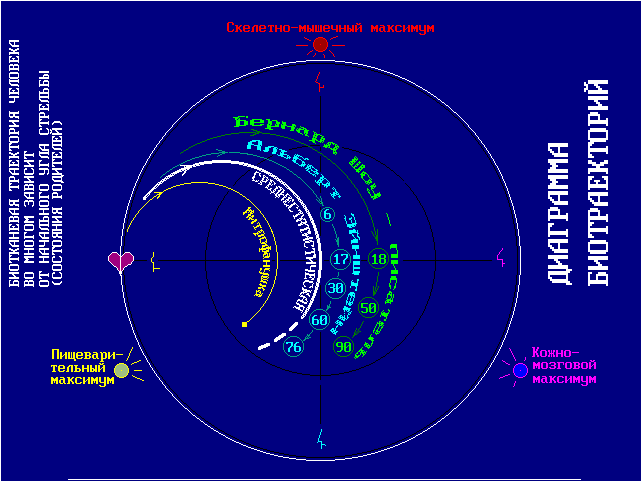
From birth to old age, the tip of the nose and the corners of the lips gradually drop. And also, to some extent, the tissue composition of the body changes. But for different people, this process has a different start and, therefore, a different finish.
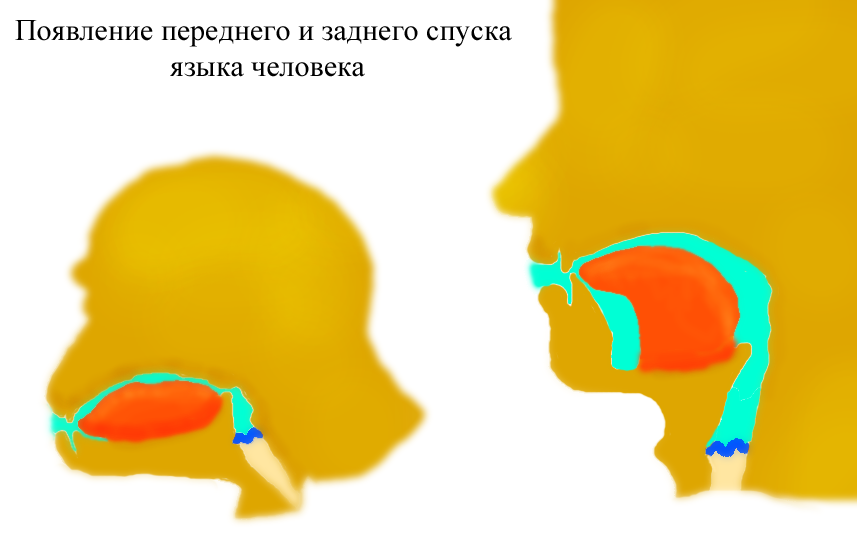
In the process of evolution of the monkey into a human, the sublingual chin cavity has increased and the space between the tongue and the larynx (pharynx) has increased. This increased the mobility of the language and made the language of communication more diverse.
Since the language of animals is constrained, they make simple guttural sounds, reinforced by the repetition: "meow-meow." Then there were simple nouns from a repeating syllable, like "ma-ma", "pa-pa". Then appeared (?) the first full-fledged language -
"root", where there were no cases and tenses. The second, more developed stage is compound languages: where tenses, cases and other forms are formed by special prefix words (separate or fused).
The highest stage of language development is "wrong" languages, where these compositions are simplified for pronunciation in accordance with the anatomy of the vocal apparatus: stresses are transferred, vowels change, and so on.
In official science, these three successive stages of language development are called: "isolating", "agglutinative", "inflectional". The level of development of the vocal apparatus is approximately equal to the size of the chin.
It grows from the equator of Africa to the Moscow region. And further to the east, due to excessive frosts, it decreases slightly. As a result, in the Moscow region, the pronunciation is the least guttural and is produced mostly by the tip of the tongue.